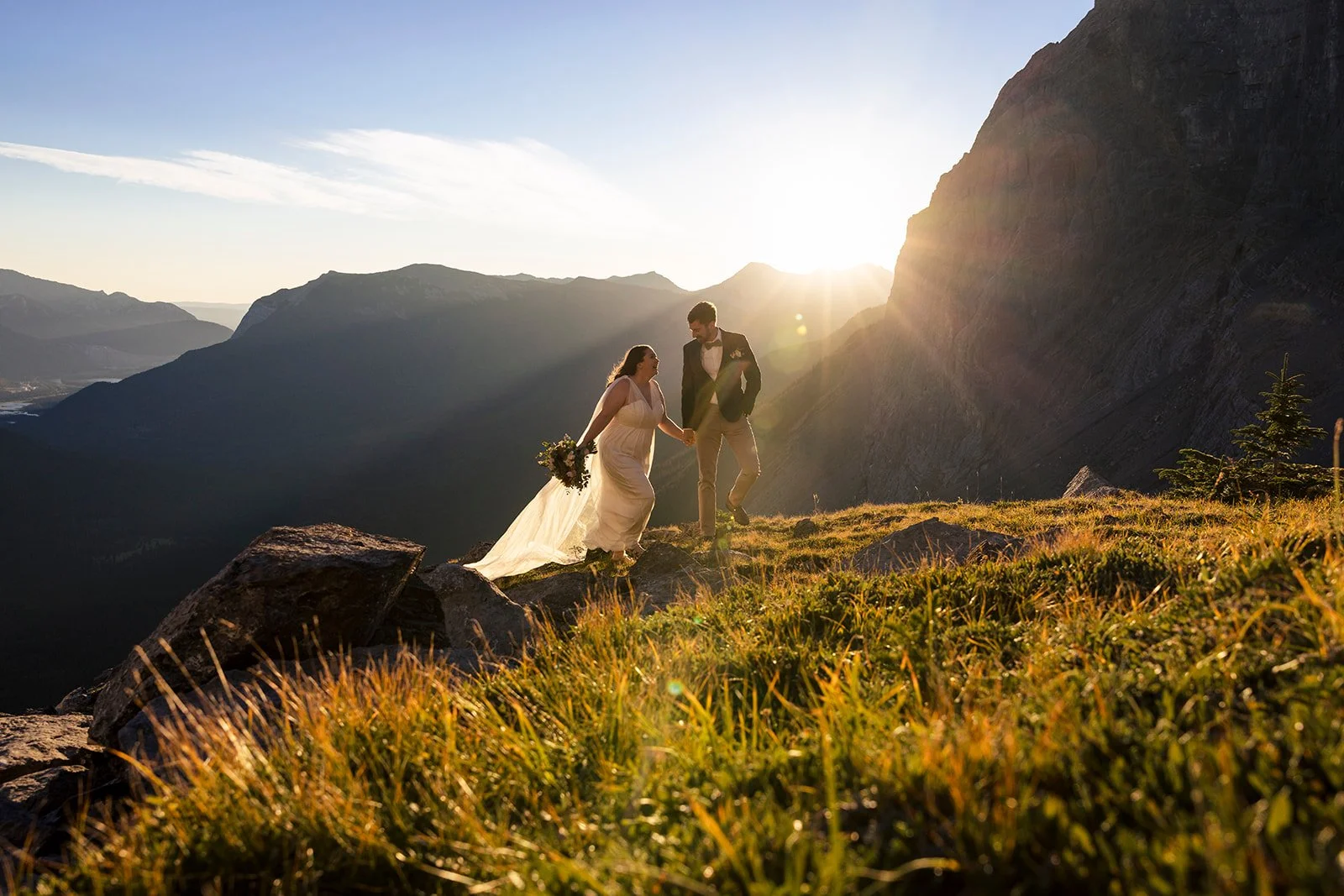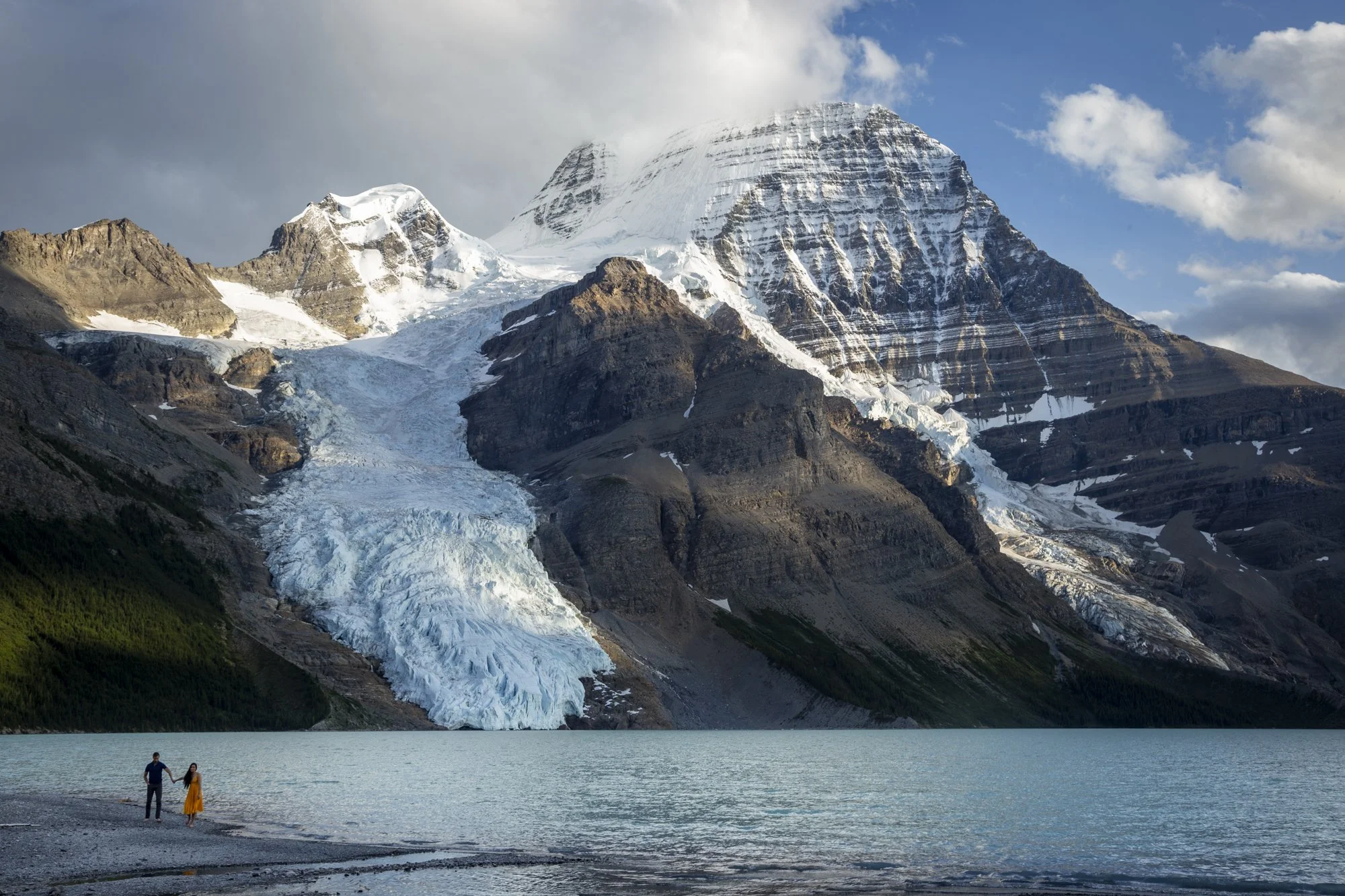How to Plan your Hiking Elopement in Kananaskis, Banff and the Canadian Rockies
Planning a hiking elopement in Kananaskis, Banff, and the Canadian Rockies is an incredible way to exchange vows. You’ll get to enjoy being surrounded by untouched wilderness and breathtaking landscapes. No doubt you’re excited, you’ve seen the pictures online and starting researching for yourself, but where do you start? Here’s our step-by-step guide to making your adventure elopement seamless, stress-free, and unforgettable.
1. Choose Your Perfect Hiking Location
The Canadian Rockies are home to endless stunning trails, each offering a unique experience. If you plan to base yourself in Canmore, Banff or even Lake Louise then you should start with considering the following areas:
Kananaskis Country
What used to be a legitimate hidden gem of an area is now proudly on the map as one of the go-to destinations for hikers from all over the world. Kananaskis spans just over 4000 square kms and when we say it has somewhere for everyone, we really do mean it. Take your pick from roadside, stroll up lakes with easy access for the whole family or go huge with 3000m+ peaks and some of the most picturesque multi day trails out there.
Banff National Park
What can we say about Banff? Well, it is iconic. There’s a reason it makes it onto everyone’s travel bucket list. You’ve seen the pictures, now is our chance to exchange vows in one of those magical scenes. With a huge variety of trails and viewpoints, just like Kananaskis, there really is somewhere for everyone. Banff is home to some of the best turquoise lakes in the area.
Yoho & Jasper National Parks
Technically, you’ll be stepping outside of Banff and Kananaskis, but who cares? Less crowded, equally impressive and when you know where to look, some of the scenery and places you can go, in our opinion can outweigh the experience on offer in comparable locations in Banff and Kananaskis.
Overall, start by considering your ideal scenery, trail difficulty, and accessibility for you and any guests joining. These factors may well narrow the places to choose from!
2. Consider the Best Time of Year
Seasons dramatically affect hiking conditions here in the Rockies. The seasons here are what we would call a guideline, not a guarantee. It really is no exaggeration that it can, and usually does snow every month of the year (if you’re in the right place!). So with that said, read on to get some more help for what to expect in each season in the mountains of Banff, Canmore and Kananaskis.
Summer (June–September)
Summer is generally the most popular time of year in all places. Long daylight hours and warmer weather draw the crowds. Not to mention, as we move into July, most trails are snow free and this makes way for wildflowers, widlife and some pretty incredible outdoor spaces to explore.
Fall (September–October)
This time of year feels quite short lived and is very subject to the first snowfalls and frosts of winter. It can happen anytime, but assuming it doesn’t happen too early you can expect cooler temperatures and in the right places, stunning golden hues of the foliage splashed around the valleys. Towards the end of September, the golden larch trees draw the crowds once again and in some areas, it will be busier than Summer - yes you read that right! With that said, local knowledge is key and escaping the crowds isn’t hard when you know where to go.
Winter (November–March)
Early winter is starting to feel like an extension of Fall with snowfalls becoming more delayed until closer to December. With that said, colder temperatures can be expected and much shorter daylight hours. At some point through winter, we will experience our “cold snap” which typically is a 2-4week window of very cold weather (-20 to -40 degrees Celsius). This cold snap could happen anytime and usually it happens December to February, with no rhyme or reason. Despite that, winter allows for those magical snow-covered scenes, though hiking isn’t exactly the go-to activity. Trails are snowbound, inaccessible and in some places, closed.
Spring (April–May)
Spring is a trickier time of year to set decent expectations for. Let’s be clear though, Spring in the Rockies is not what you might think. Think of it as an extension of winter. Most areas of interest are snowbound and look like winter still. The daylight hours are getting longer and things are warming up which is great, but don’t expect wildflowers and turquoise waters. This is the part that everyone misses - lakes like Lake Louise and Moraine Lake are usually frozen until June so if that is what you have in your mind, plan for summer.
3. Understand Legal Requirements
To make your elopement official, at the very least you will need:
A Marriage License
You’'ll need your Alberta marriage license, provided of course that you are eloping in Alberta. If you happen to be exchanging vows in BC then be sure to get a BC marriage license. If you are unfamiliar with the process, you can find out all you need to know about this in our dedicated blog.
An Officiant & Two Witnesses
An officiant is necessary to carry out the legalities for the cermony. In addition, two witnesses are required! Usually, for these celebrations, we are the witnesses, which makes it even more important to make sure that your photographers are a good fit for your plans! If you need any recommendations for officiants, let us know and we can point you in the right direction.
4. Plan for the Hike
Never hiked in the mountains before? Well, we’re not saying this “isn’t for you” but we would want to set some realistic expectations for you. There is no doubt, a hiking elopement is surreal. No matter the time of day, you get to soak up the experience outdoors together and share in something that very few people get to enjoy. With thats said, whilst it looks like an absolute dream, don’t get caught out thinking it’s all smiles and roses. You have to put in the leg power to get there and depending on the time of year and weather, you can expect the associated discomforts of backcountry travel - bugs, sweat, sunburn and of course fatigue and tired legs! If the idea of the physical input is a deal breaker then the best option for you is to explore a heli-elopement and this is something we specialize in. That said, if you have your expectations in the right place, have some hiking experience under your feet and are dreaming of the sights, smells and sounds of being out in the mountains with unreal views then read on.
Choose attire wisely
If you are a keen hiker already, no doubt you have your bases covered. If you aren’t as familiar then you should look for breathable, comfortable, and weather-appropriate wedding outfits. Don’t forget that you can change at the top, or end destination so what you actually hike in doesn’t have to be “hiking suitable”. Many couples choose to pack their wedding attire onto their hiking packs and hike in more comfortable gear.
Footwear matters
Hiking boots are a must for safety and comfort. Once again, you can pack your more formal shoes if you want to, though we’ve found many of our couples embrace this side of the story telling and are very happy to wear their hiking boots throughout the entire celebration.
Pack essentials
Water, snacks, layers, headlamps, and a small first aid kit to name a few. We feel like we can never leave home without everything we need and whilst you don’t want to burden yourself with extra pack weight, form experience, there’s many things you’d rather have and not need than the alternative.
Hire an experienced photographer
What else did you expect to hear from a couple of local photographers? Well, this is pretty crucial and it might not be for what you think! From our own hiking experience, we know that not all locations suit a certain time of day. We really do know our stuff when it comes to where to be and at what time. Better yet, there’s not many locations we haven’t personally hiked. We can help fine tune the planning to let you know if the location you want to hike is suited for sunrise or sunset and what the views and trail are like. Do you love wildflowers? What about lake views? Is it important for the lake to be turquoise, or a deeper blue? This is the level of our planning we expect and our experience helps us know how and when to pivot, when you factor in wildfires, wildlife closures and trail warnings.
5. Make It Your Own
Your hiking elopement should reflect your love story! Consider adding:
A private vow exchange at sunrise or sunset
A post-ceremony picnic with champagne and local treats
A multi-day backpacking adventure for a truly immersive experience
Pick a location that holds special significance or offers stunning views
Wear personalized accessories, attire, footwear or choose colours that complement the landscape
Bring along your favorite gear, like a guitar, polaroid camera, or even a small painting kit to share the activity together
Opt for a dried flower bouquet, floral crown, or a backpack patch with your wedding date
If the trail allows, bring your dog along for the adventure.
End the day with a cozy fire or a quiet moment under the stars.
6. Prepare for Leave No Trace (LNT)
Respecting the environment ensures future couples can enjoy these landscapes too. Follow LNT principles by packing out everything you bring, staying on designated trails, and avoiding fragile alpine areas. If you really want to nerd out a little more on these principles, we’ll elaborate with a little more info:
Plan Ahead and Prepare
Research regulations, weather, and trail conditions to avoid unnecessary impact.
Travel and Camp on Durable Surfaces
Stick to established trails and campsites to prevent damage to fragile ecosystems.
Dispose of Waste Properly
Pack out all trash, leftover food, and anything you bring on the hike with you.
Leave What You Find
Avoid picking flowers, disturbing wildlife, or taking natural objects as souvenirs.
Minimize Campfire Impact
If fires are allowed, keep them small and use established fire rings.
Respect Wildlife
Observe from a distance, never feed animals, and store food properly to avoid attracting them.
Be Considerate of Others
Keep noise levels low, yield to other hikers, and respect the solitude of nature.
For hiking elopements, this means things like avoiding confetti, using biodegradable decor, and sticking to designated areas. This is something we can definitely give you a little more guidance on throughout the planning stages.
7. Hire Experts Who Know the Area
Working with vendors who specialize in adventure elopements can make all the difference. Look for photographers and officiants who are experienced with the area and lean on their local knowledge and advice. One of the key parts of this that we often see overlooked is hiking times and distances. It can take a considerable amount of time longer to get where you’re going in the mountains. If you are not familiar with the elevation and fitness required then don’t bite off more than you can chew. There would be no worse feeling on your sunrise wedding elopement to not make the viewpoint on time, if at all, only to witness sunrise from a sub par position and feel it was all for “nothing”. This sounds a little dramatic, but, we really consider the entire experience, not just the short time you spend on the summit.
Ready to Plan Your Hiking Elopement?
A hiking elopement in Kananaskis, Banff, or anywhere in the Canadian Rockies is an unforgettable way to say “I do.” With the right planning, you can create an experience that is adventurous, meaningful, and uniquely yours. If you have more questions that we can help with and you want to continue the conversation then reach out and paint us a picture of what you envision and we can go from there!
Kahli & Leo
Wild Alpine Image Co.













